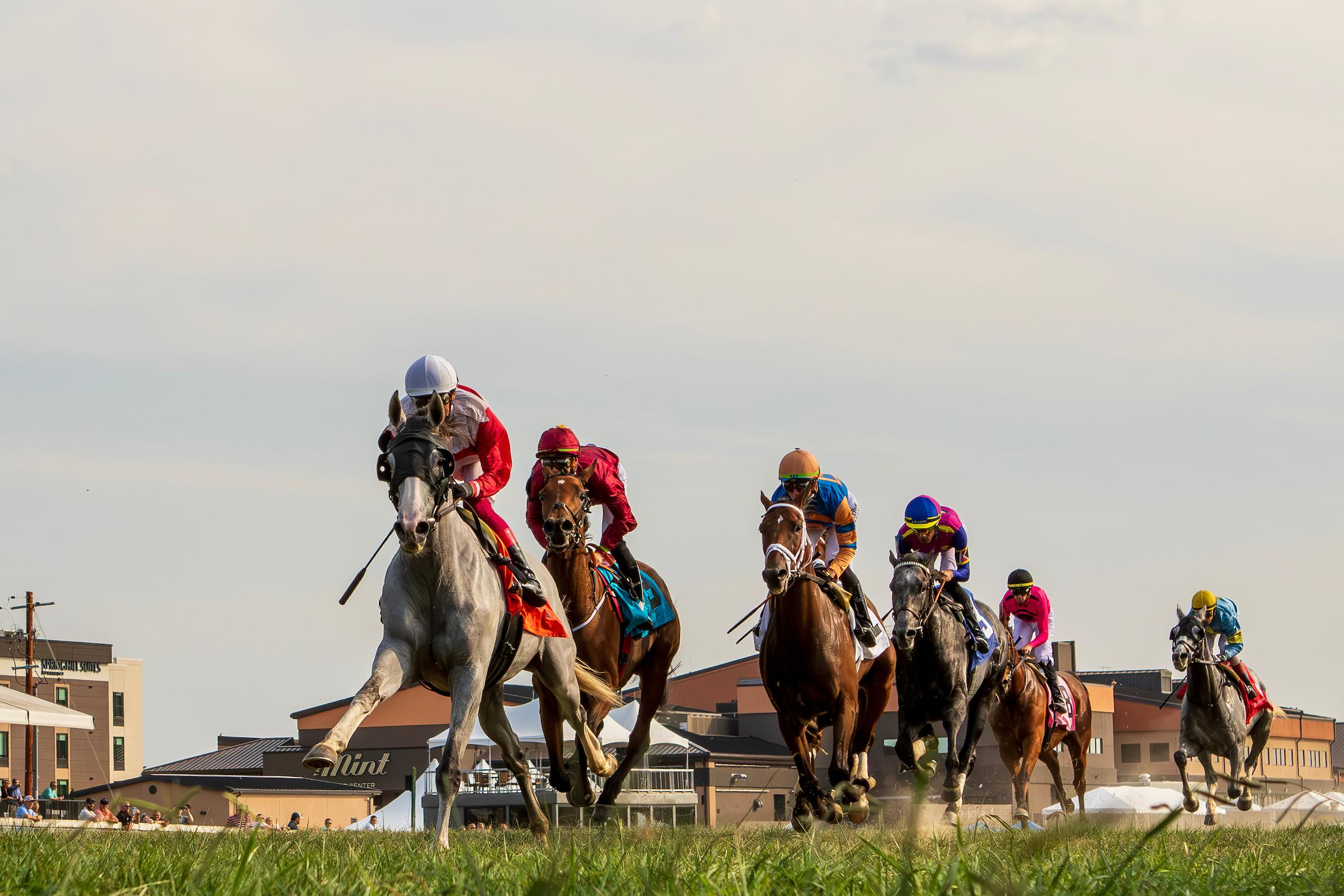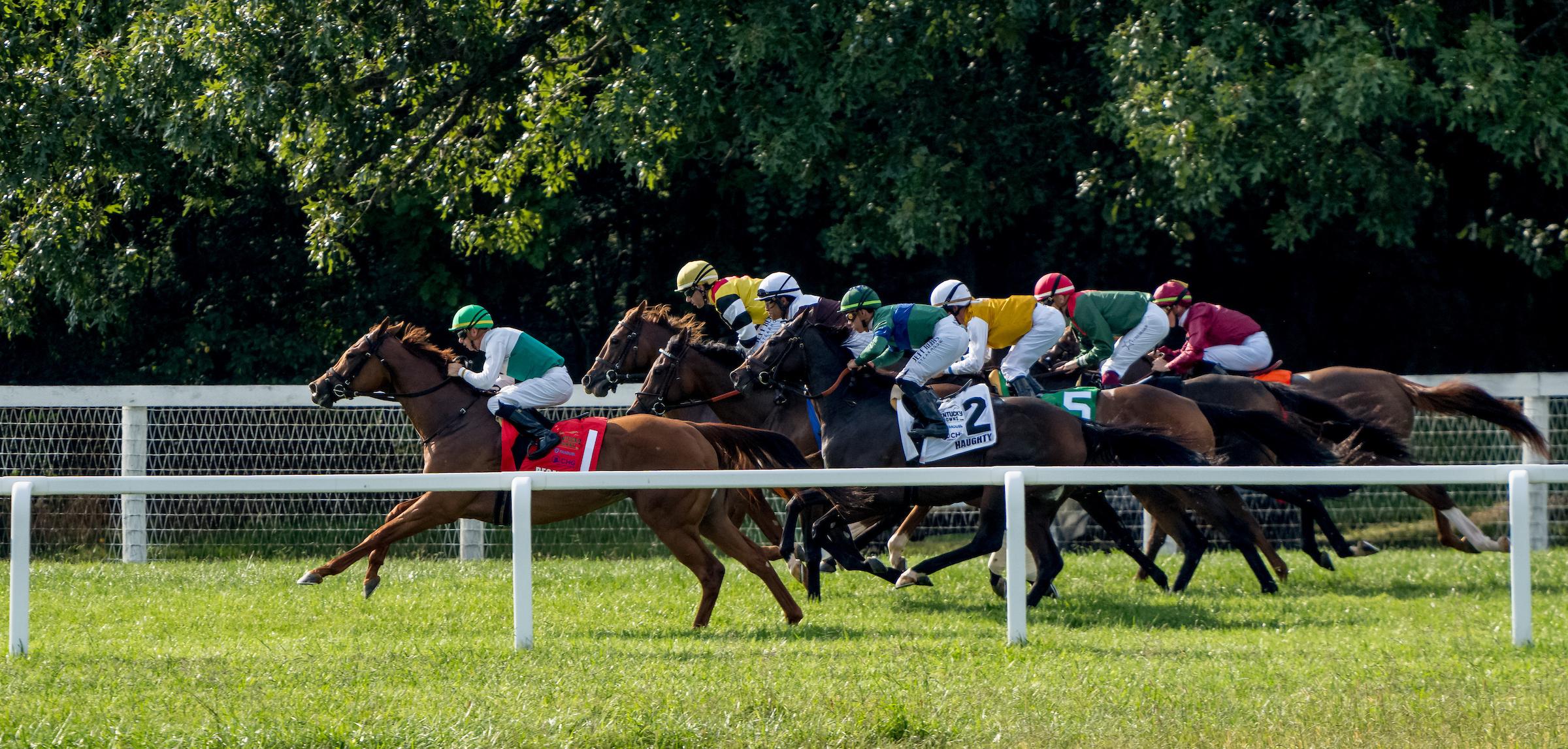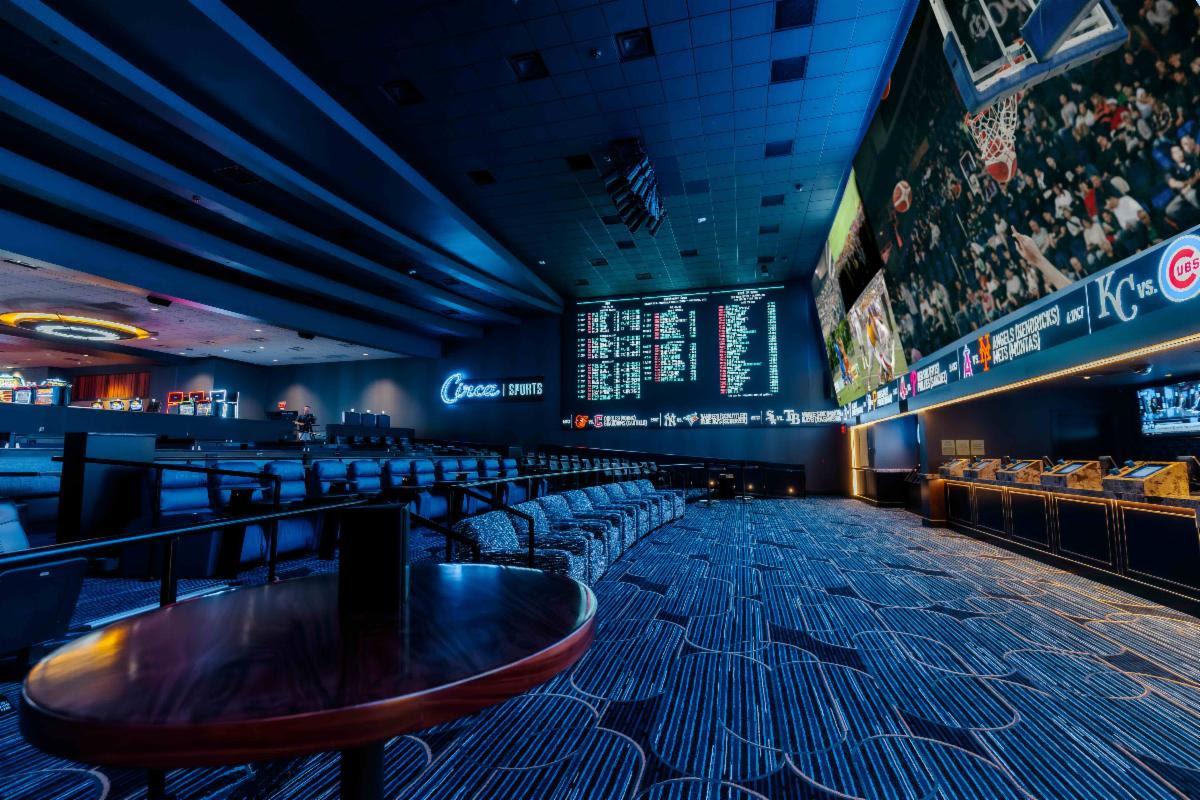
Nelson Bunker Hunt: An Oilman with an Eye for Racehorses

My, how times have changed. Fifteen years ago, Kentucky Downs was a quaint countryside turf-only racetrack within eyesight and earshot of I-65 on the Kentucky/Tennessee border featuring a main building that resembled an old Southern estate and sparse amenities. Now, drivers passing to and from the sister states behold a multifaceted, completely modern gambling and entertainment venue that draws scores of fun-seeking patrons through its doors year-round.
The transformation has been profound and comprehensive. While Kentucky Downs still holds a very brief boutique meet in late August and early September as it did going all the way back to the 1990s when the track was called Dueling Grounds, the amount of money wagered on races and offered in purses during this meet has skyrocketed over the past decade.

This fall, Kentucky Downs in Franklin is preparing for its most lucrative and competitive meet yet, one that offers a record $41.7 million in purses over a seven-day period and featuring 18 stakes races. The action starts Aug. 28, with subsequent dates set for Aug. 30 and 31 and Sept. 4, 6, 7, and 10.
The catalyst behind Kentucky Downs’ expansion is easy to spot once you walk into the main facility, called the Mint Gaming Hall. Slot-like historical horse racing (HHR) machines first appeared at Kentucky Downs during fall 2011, and since then they’ve been installed at every racetrack across the commonwealth, with a percentage of their handle helping to bolster the horse industry at all levels. The Kentucky General Assembly codified HHR machines as a legal form of parimutuel gaming in 2021, stabilizing the revenue source for the future.
Since 2012, total horse racing handle for the boutique Kentucky Downs meet has increased from $7.5 million (five days) to $90.1 million (seven days) last year, and purses offered from just over $2 million to $34.6 million. The purse structure for this year’s slate of races includes substantial increases marked for Kentucky-bred race winners from the state’s Thoroughbred development fund. The richest race offered in 2025, the DK Horse Nashville Derby Invitational Stakes set for Aug. 30, thus has a potential purse of $3.5 million if a Kentucky-bred runner wins ($2 million otherwise).
Given the amount of money up for grabs, it’s not surprising that what was once a brief stopover for mainly Kentucky-based stables ahead of the prestigious Keeneland fall meet has become a magnet for top turf owners, trainers, and jockeys from across the U.S. and even from overseas. That’s made racing at Kentucky Downs incredibly exciting for fans and lucrative for sharp bettors. Here’s an overview of what to expect this year at the highly anticipated meet.
A Unique Watching and Wagering Experience
The old Kentucky Downs had its charms, no doubt, first among them the novelty of wagering on all-turf racing each race day. Well, that thrill persists, because Kentucky Downs’ turf course itself has remained the same over time – an undulating 1 5/16-mile grass expanse, shaped somewhat like a kidney, that is truly unique in North American racing.
Horses navigating a mile and a half at Kentucky Downs must maneuver through a sharp first turn, travel down and then up a dip in the course on the backstretch (where they might briefly disappear depending on where you’re watching the race from), and then sweep around a bulging round far turn before hitting the long homestretch. Attending live racing therefore offers American racing fans their only chance to get a first-hand sense of what many European turf courses are like.
Watching Kentucky Downs on TV does not come close to giving you the full picture, so to speak, of the course’s challenges – but for those who are tuning in, expect improvements to the video coverage, including usage of a drone camera and cable-cam running through the stretch. All of the track’s races will air on FanDuel TV featuring analysis from Caton Bredar, Jess Stafford, and Britney Eurton, with Nick Luck present for the first three days. In addition, NBC will show two hours of racing Aug. 30, anchored by Luck and Eurton. Michael Wrona returns to call the races at Kentucky Downs this meet after previously announcing in 2019 and 2020.
The huge purses offered at Kentucky Downs have unsurprisingly resulted in field sizes averaging over 10 horses per race in every year save one since 2014 (and that was 9.98 in the COVID year of 2020). That makes for a very intriguing and difficult handicapping challenge for horseplayers, but the payoffs make it one worth tackling. The average $2 win bet at Kentucky Downs during its 2024 meet paid $16.18, with a $1 exacta paying $74.08 and .50-cent trifecta $300.72.
Multi-race payouts were also bountiful last year ($275.76 for Pick 3, $2,348.03 for Pick 4, and $15,107.48 for Pick 5, all 50-cent base bets). This year, Kentucky Downs debuts a $1 Pick 6 bet for the final six races on each card that has a major and minor pool split 75% and 25%, respectively. If no one hits 6-of-6 winners in the major pool, it carries over to the next day’s card (mandatory payout on closing day Sept. 10), while the minor pool will be paid out to 5-of-6 winners.
For tournament players, this year Kentucky Downs adds Race Lens as the sponsor of its King of the Turf Handicapping Challenge held Sept. 6. The one-day tournament has a buy-in of $2,500 ($1,500 for bankroll, $1,000 to prize pool) with an estimated first-place payout of more than $25,000 in addition to the winning bankroll earnings. At least five packages to the 2026 National Horseplayers Championship in Las Vegas will also be awarded as well as two berths to this year’s Breeders’ Cup Betting Challenge.
Race Lens also is sponsoring two live-money, play-in tournaments held on opening Thursday, Aug. 28 ($300 entry) and Sunday, Aug. 31 ($400 entry). Race Lens, an interactive past performance product from Equibase, is offering a one-month unlimited subscription covering Kentucky Downs’ meet for only $1 using promo code KYDOWNS25.
And finally, free Equibase past performances for the 2025 Kentucky Downs meet are available at the track’s website – click here to access.
Turf Trends (courtesy of Noel Michaels)

There were 76 total races run at the 2024 Kentucky Downs meet: 34 sprints and 42 routes.
In sprints in 2024, the Kentucky Downs turf course favored speed horses that raced on or near the pace within a length of the lead. Those front-runners won 18 of the 34 sprints to account for more than half of the races (53%).
The other course trend in 2024 Kentucky Downs turf sprints was a negative bias against inside post positions. With an average field size in these races of 11.18 runners per race, horses from inside posts 1-3 fared poorly and won only six of the 34 sprints for 18%. Horses breaking from middle posts 4-6 won 12 of the sprints (35%) and horses from posts seven and outward did the best with 16 turf sprint wins (47% of the races).
The Kentucky Downs course played differently in routes than in sprints in terms of preferential running styles at the 2024 meet, and handicappers should take note. Unlike in sprints, speed horses had no advantage in route races. The most effective running style in routes belonged to the closers coming from four or more lengths off the pace. Closers won 18 of the 42 Kentucky Downs routes last year to account for 43% of the wins.
When looking at the best post positions for Kentucky Downs routes based on last year, the outside and middle were better than the inside. Similar to what we saw in sprints, horses from the inside posts struggled in routes with just 11 wins in the 42 races to account for 26% of the wins. The best place to be in the starting gate in routes were the middle posts 4-6, which accounted for 16 of the 42 wins (38%).
Jockeys and Trainers: Longstanding Locals Plus Invaders
Soon after this year’s meet starts, a new jockey could take over the all-time wins crown at Kentucky Downs. Tyler Gaffalione currently sits at 63 wins, just two behind Brian Hernandez Jr., and Gaffalione has earned riding titles (either solo or shared) in four of the last five meets. Both Gaffalione and Hernandez will be among the most active jockeys throughout the entirety of Kentucky Downs’ seven-day schedule, and they’ll be joined by Jose Ortiz (two-time meet leader) and international legend Frankie Dettori, who rode this course for the first time in 2024 and posted eight victories, four in stakes races.
Other Kentucky-based jockeys who will ride often at Kentucky Downs include Florent Geroux (two-time meet leader), Jaime Torres, and Luan Machado. And once Saratoga ends its summer meet on Sept. 1, expect most of the top riders there (Irad Ortiz Jr., Flavien Prat, Joel Rosario, Luis Saez) to set up shop on the Kentucky-Tennessee state line for Kentucky Downs’ final cards.
The two all-time winningest trainers at Kentucky Downs, Mike Maker and Wesley Ward, are known year-in and year-out to prepare many of their best horses to run on this course in September. They’ll be at it again in 2025 and their entrants should play to each trainer’s specialty – Maker’s going long-distance and Ward’s sprinting. Hall of Famer Steve Asmussen, Brendan Walsh, and Joe Sharp have been very successful in recent meets and will have a big presence once again this year. Other trainers known for their horses’ turf achievements, such as Chad Brown and Graham Motion, will bring a handful to Kentucky Downs for big races, and the track’s increasing international profile means that we should see several European trainers on the grounds, especially competing in lucrative stakes (Kentucky Downs has built a 22-stall isolation barn to accommodate Euro shippers).
Planning to Visit Kentucky Downs? What You Need to Know

Attending live racing at Kentucky Downs used to be a drive up, park, and roam freely experience, but no longer. It’s still free to park and also to attend the races in the far turn area near the Mint Gaming Hall, where tailgating is permitted, food trucks are set up, and patrons can enter and leave the casino/simulcast/sports book inside the big building throughout the day.
Tickets are required for areas located in front of the homestretch and down at the finish line, with several options available ranging from the open-air Finish Line Pavilion and enclosed, air-conditioned VIP Chalet (both offering inclusive buffet, snacks, and open bar) to the Stretch Run section near the eighth pole where seating is on a first-come, first-served basis under a tent and more food trucks are located. Advance purchase is encouraged, with tickets to the higher-end Finish Line Pavilion and VIP Chalet going fast. Click here to purchase and for more information.
Kentucky Downs is putting the final finishing touches on a major upgrade to the Mint Gaming Hall itself this summer, creating a state-of-the-art gambling palace. Last week, the facility opened a Las Vegas-style sports book comparable to what you’ll see at MGM Grand or Bellagio. Circa Sports Kentucky features an 80-foot-wide LED screen, 31-foot-wide odds board, and over 5,100 square feet of space with premium seating available, plus a live broadcast studio where episodes of the popular VSIN gambling show will be taped. This new sports book promises to be humming particularly on the live Saturday and Sunday race dates of Aug. 30-31 and Sept. 6-7 with college football well underway and the NFL getting started. Upstairs at the Mint Gaming Hall, a brand-new simulcasting area is set to open during the live meet with a bar and lounge, racecourse views, and a VIP section.
Nashville Day (or Night) Trip

When I last wrote a preview of Kentucky Downs in 2019, I mentioned that “the Music City, which is only a 45-minute drive south of the track on I-65, is in the midst of a dizzying economic development, construction, and tourism boom.”
That doesn’t even begin to describe Nashville now. Since the COVID-era lockdowns ended, Music City has exploded in population (160,000 added between 2020 and 2024 according to the U.S. Census) and entrepreneurial activity. Back in the 2000s and into the early 2010s, the downtown blocks south of Broadway used to be populated mainly by warehouses, rundown or vacant lots, and the occasional dive bar. Now, they’re packed with high-rise hotels and office/residential buildings, turning the entire downtown area into a construction-fest, the most expensive project being a gargantuan NFL football complex being built right next to the existing home of the Tennessee Titans, Nissan Stadium.
Broadway remains the center of downtown activity, and while it has more than its share of honky-tonk tourist traps and becomes overrun by roving and rowdy young ’uns after sundown, a new development on the block adjacent to both the Ryman Auditorium (original site of the Grand Old Opry) and Bridgestone Arena (where the NHL's Predators play) offers more adult-centric alternatives. These include a good food hall, a couple of upscale restaurants/bars, and best of all, the National Museum of African American Music, which opened in 2021 and enhances its artifact collection with superb audio-visual elements.
As for the rest of Broadway, the iconic Tootsie’s Orchid Lounge is still worth a quick visit just to soak in the ambience of the hundreds of country music legends that used to drink there. Otherwise, skedaddle and head out into Nashville’s perimeter for neighborhoods such as Five Points (hipster haven), West End/Vanderbilt (collegians plus the famous Parthenon), and 12 South (a walkable section near Belmont University populated with many shops and eateries).
Nashville’s art-house movie theater, the Belcourt, is located near Vanderbilt, and there are so many famous music venues and stores contained in the metro area checking them out could easily take up an entire day/evening excursion. Some of them are City Winery (south downtown area), Jack White’s Third Man Records/Blue Room Bar (ditto), the Bluebird Café (southwest suburbs), the Basement East (Five Points), Grimey’s Record and Book Shop (northeast of downtown), and Exit In (near Vandy).
Regarding food, the hot fried chicken craze started in Music City, and Hattie B’s and Prince’s are two of the most popular spots. Puckett’s downtown has been an area institution providing the famous Nashville “meat and three” since the 1950s. And the vegan Sunflower Café serves up delicious, fresh meals from its location in the buzzing Berry Hill neighborhood a few miles south of downtown and close to I-65.